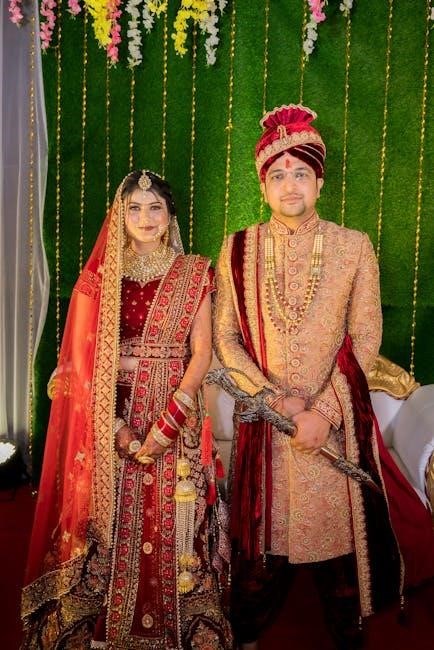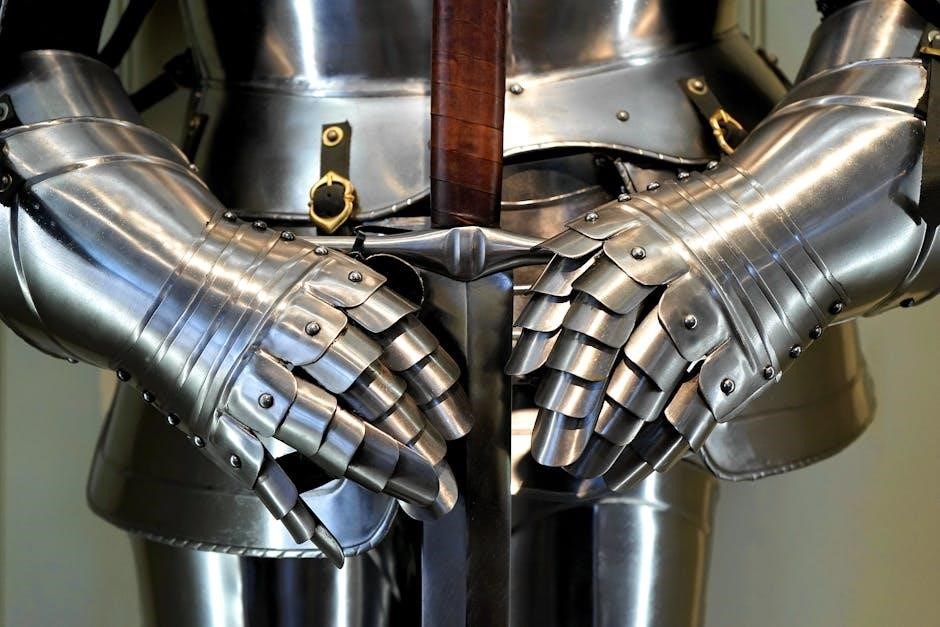Buying a sword is a significant investment, blending art, history, and functionality․ Whether for collection, combat, or display, careful consideration and research are essential․ This guide helps you navigate the process, ensuring your purchase aligns with your needs and budget․
Why Buy a Sword?
Buying a sword can be a meaningful investment, blending art, history, and personal passion․ For collectors, swords offer a connection to cultural heritage and historical significance․ Martial artists may seek functional swords for practice, while others appreciate their craftsmanship as decorative pieces․ Swords also serve as symbols of heritage or profession․ Whether for display, combat, or collecting, purchasing a sword is a decision that combines practicality with a deep appreciation for history and craftsmanship, making it a rewarding and lasting acquisition․
Understanding the Purpose of Your Sword Purchase
Defining the purpose of your sword purchase is crucial for making an informed decision․ Are you seeking a functional sword for martial arts or combat, or a decorative piece to appreciate its craftsmanship? Collectors often focus on historical accuracy and rarity, while others may prioritize versatility for reenactments or practice․ Understanding your intent helps narrow down choices, ensuring the sword aligns with your needs, budget, and preferences․ This clarity guides your selection process, whether you’re investing in a battle-ready weapon or a cherished collectible․

Types of Swords
Swords vary widely, each with unique designs and historical backgrounds․ From the katana’s curved elegance to the rapier’s precise dueling style, each type serves distinct purposes and aesthetics․
Katana: The Iconic Japanese Sword
The katana, a symbol of Japanese culture, is renowned for its curved, single-edged blade and distinctive hamon․ Historically wielded by samurai, it embodies precision and artistry․ Modern katanas are crafted using traditional methods, often with high-carbon steel for strength and sharpness․ Collectors and practitioners alike value them for their historical significance and functionality in martial arts․ Proper maintenance, including cleaning and storage, is crucial to preserving their beauty and performance․ Whether for display or use, the katana remains a timeless choice for enthusiasts worldwide․
Longsword: A Versatile Medieval Weapon
The longsword, a two-edged blade originating from Germany and Switzerland, thrived in the 15th and 16th centuries․ Known for its versatility, it excelled in both cutting and thrusting, making it a favorite among knights and men-at-arms․ Its length, typically between 44 and 50 inches, allowed for dynamic combat styles․ The longsword’s design, with a cruciform hilt and balanced weight, enabled precise control and powerful strikes․ Today, it remains popular among historical enthusiasts and collectors, cherished for its historical significance and martial prowess․ Its enduring appeal lies in its blend of functionality and craftsmanship․
Rapier: The Elegant Dueling Sword
The rapier, a sleek and agile weapon, emerged in the 16th and 17th centuries as the favored choice for dueling․ Its slender, double-edged blade, measuring 30 to 45 inches, was designed primarily for thrusting․ The rapier’s long, intricate hilt, often adorned with decorative designs, provided excellent hand protection and control․ It became a symbol of elegance and skill, widely used by nobility and fencing enthusiasts․ Its focus on precision and finesse made it a cornerstone of early modern European martial arts, blending artistry with deadly efficiency in combat․
Great Sword of War: The Mighty Two-Handed Sword
The Great Sword of War, a formidable two-handed weapon, dominated battlefields in the 16th and 17th centuries․ Its imposing blade, measuring 50 to 72 inches in length, required immense strength and skill to wield․ Designed for close combat, it excelled in both cutting and thrusting, making it a versatile and intimidating force on the battlefield․ Often weighing between 6 to 10 pounds, this sword was a favorite among warriors for its raw power and ability to deliver devastating blows, reflecting the brutal efficiency of medieval warfare․
Saber: The Curved Cavalry Sword
The Saber, a curved, single-edged sword, became iconic for its use by cavalry units in the 18th and 19th centuries․ Its curved design allowed for powerful slashing attacks from horseback, making it a favorite in battles like the Napoleonic Wars․ Often associated with military officers, the Saber featured a decorative hilt and a blade designed for both functionality and aesthetics․ By World War I, it transitioned to a ceremonial role, symbolizing rank and tradition․ Its curved blade and single edge made it ideal for cutting and slashing, while its historical significance adds value for collectors․
Scimitar: The Single-Edged Middle Eastern Sword
The Scimitar, a curved, single-edged sword, has deep roots in Middle Eastern and North African history․ Its curved design allowed for effective slashing attacks, making it a favored weapon for cavalry in regions like Arabia, Persia, and Turkey․ Often adorned with intricate designs, the Scimitar symbolized status and craftsmanship․ Its popularity extended into the Napoleonic Wars, where it became a symbol of exotic elegance․ Today, collectors prize Scimitars for their historical significance, unique aesthetics, and the artistry reflected in their construction, making them a sought-after piece for enthusiasts of Middle Eastern weaponry․
Gladius: The Roman Short Sword
The Gladius, a iconic Roman short sword, was a primary weapon for Roman legionnaires, designed for close combat․ Its short, narrow blade typically measured 18-24 inches, with a pointed tip for thrusting․ The single-edged design featured a sharpened edge for slashing, while the back remained blunt․ The Gladius was known for its practicality and effectiveness in tight formations․ Its hilt included a guard, grip, and pommel, often made from wood or bone․ Originating in Spain, the Gladius became synonymous with Roman military prowess, symbolizing discipline and efficiency․ Today, it remains a popular choice for historical enthusiasts and collectors․

Claymore: The Scottish Two-Handed Sword

The Claymore, a formidable Scottish two-handed sword, was prominent during the 15th to 17th centuries․ Its long, double-edged blade typically spanned 40-55 inches, with a distinctive crossguard and forward-sloping quillons․ Designed for powerful cutting and thrusting, the Claymore was a favorite in battle, reflecting Scottish martial traditions․ Its name means “great sword” in Gaelic, symbolizing strength and heritage․ The Claymore’s robust construction and balanced design made it a versatile weapon for both offense and defense, cherished by warriors and collectors alike for its historical significance and craftsmanship․

Materials and Construction
Swords are crafted from various materials, with carbon steel and stainless steel being common choices․ Construction involves forging, heat-treating, and assembling the blade, hilt, and guard to ensure durability and functionality․
Blade Materials: Carbon Steel, Stainless Steel, and More
Sword blades are typically made from carbon steel, known for its strength and edge retention, or stainless steel, prized for corrosion resistance․ Other materials like Damascus steel offer unique aesthetics and durability․ Carbon steel is often preferred for functional swords, while stainless steel suits decorative pieces․ High-carbon content ensures a sharper edge, but requires proper maintenance․ Damascus steel, with its wavy patterns, combines beauty and resilience․ Each material serves different purposes, from combat to display, making it essential to choose based on intended use and care capabilities․
Hilt and Guard: Design and Functionality
The hilt and guard are crucial for both functionality and aesthetics․ The guard protects the hand from incoming blades, while the hilt provides a secure grip․ Materials like leather, wire, or wood are common for the grip, ensuring comfort and control․ The pommel acts as a counterweight, preventing the sword from slipping․ The guard’s design varies, from simple to ornate, often reflecting historical origins․ A well-designed hilt enhances balance and maneuverability, while the guard’s strength is vital for combat․ Together, they ensure safety and precision, making them essential components of a sword’s construction․
Scabbard and Belt: Protection and Carrying Options
The scabbard and belt are essential for protecting and transporting your sword․ Scabbards, made from materials like leather, wood, or metal, shield the blade from damage․ Belts, including over-the-shoulder baldrics, offer convenient carrying solutions․ Decorative elements like tassels can enhance functionality and style․ Proper fit and durability are key to ensure safe carriage․ Whether for display or use, a well-crafted scabbard and belt preserve your sword’s condition and allow easy access when needed․ They balance practicality with historical authenticity, complementing the sword’s overall design and purpose․

Maintenance and Care
Proper maintenance ensures your sword remains in excellent condition․ Regular cleaning, polishing, and storage prevent rust and damage․ Sharpening maintains its edge, preserving functionality and appearance․ Consistent care extends the sword’s lifespan, protecting its historical and aesthetic value for years to come․ Attention to detail ensures it remains a cherished possession, whether for display or use․
Cleaning and Polishing Your Sword
Regular cleaning and polishing are essential to maintain your sword’s condition and prevent rust․ Start with a soft, dry cloth to remove surface dirt․ For deeper cleaning, use mild soap and water, avoiding harsh chemicals․ Dry thoroughly to prevent moisture damage․ Polishing involves specialized metal cleaners or waxes to enhance the blade’s finish․ Avoid abrasive materials that might scratch the surface; For antique swords, gentle cleaning is recommended to preserve historical patina․ Proper techniques ensure your sword remains in pristine condition, whether for display or functional use, safeguarding its beauty and historical significance․
Storage Solutions for Swords
Proper storage is crucial to protect your sword from rust, damage, and environmental factors․ Use a high-quality scabbard or sword case to store your blade, ensuring it remains dry and clean; Hard cases or wooden boxes with padding are ideal for long-term storage․ Consider a sword stand or wall mount for display purposes, keeping it away from direct sunlight to prevent warping or discoloration․ Maintain a cool, dry environment and avoid humid areas․ For added protection, use silica gel packets to control moisture․ Regularly inspect stored swords to ensure they remain in optimal condition, preserving their beauty and functionality for years to come․
Sharpening and Edge Maintenance
Sharpening your sword is essential for maintaining its functionality and appearance․ Use a sharpening stone or diamond stone, starting with coarse grit for shaping and finishing with fine grit for polishing․ Always sharpen at the optimal angle, typically between 20° and 30°, depending on the blade type․ Avoid using sandpaper or wire wheels, as they can damage the edge․ After sharpening, clean the blade thoroughly and apply a rust-inhibiting oil․ Regular maintenance ensures your sword remains sharp, durable, and ready for use, preserving its value and performance over time․ Proper care extends the life of your investment․

Budgeting for Your Sword
Set a realistic budget based on your needs and preferences․ Consider blade materials, craftsmanship, and historical accuracy․ Allocate funds wisely to balance quality and affordability, ensuring satisfaction with your purchase․
Setting a Realistic Budget
Establishing a realistic budget is crucial when purchasing a sword․ Consider your intended use, such as display, martial arts, or collection․ Entry-level swords can start from $100-$300, while high-quality historical replicas or functional blades may range from $500 to $2,000 or more․ Military swords from the 19th and 20th centuries are often more affordable, with prices starting at $100․ Allocate funds based on material quality, craftsmanship, and historical accuracy․ Avoid overspending by prioritizing your needs and researching average price ranges for your desired type of sword․
Entry-Level Swords for Beginners
Entry-level swords are ideal for newcomers, offering affordability without compromising quality․ These swords are typically made from durable materials like stainless steel or carbon steel, ensuring longevity․ Prices often range between $50 to $200, making them accessible for those starting their collection or practice․ Many entry-level options are functional, suitable for martial arts or historical reenactments․ They provide a solid foundation for understanding sword craftsmanship and handling․ Prioritize models with positive reviews and reputable brands to ensure a worthwhile investment in your initial sword purchase․
Investing in High-Quality Swords
Investing in high-quality swords is a wise decision for enthusiasts seeking durability and craftsmanship․ Look for swords made from premium materials like high-carbon steel, known for sharpness and resilience․ Hand-forged blades and intricate designs often signify superior craftsmanship․ Historical reproductions or custom pieces can offer unique value․ Consider brands like Wilkinson Sword for authenticity and provenance․ High-quality swords may appreciate over time, making them a smart investment for collectors․ Ensure authenticity by verifying makers’ marks or historical hallmarks․ Proper maintenance and storage are crucial to preserving their condition and value․

Authenticity and Historical Accuracy
Authenticity and historical accuracy are crucial when buying swords․ Verify makers’ marks, hallmarks, and blade materials to ensure your sword aligns with its historical origins and design․
Spotting Fake or Reproduction Swords
Spotting fake or reproduction swords requires attention to detail․ Modern materials and craftsmanship often differ from historical counterparts․ Look for inconsistencies in blade etchings, uneven tempering, or mismatched parts․ A loose hilt or blade that lacks historical accuracy may indicate a reproduction․ Additionally, modern forgeries often lack the craftsmanship of authentic pieces․ Consulting an expert or verifying through reputable sources can help ensure the sword’s authenticity, especially for rare or valuable items․ Always research the seller and seek certifications when possible to avoid purchasing a fake․
Understanding Historical Sword Designs
Historical swords reflect the evolution of warfare and culture․ Each design, from the katana to the rapier, was crafted for specific purposes․ Blades varied in length, edge type, and curvature, adapting to battle needs․ Hilts were designed for grip and protection, often signifying rank or origin․ Studying these elements helps buyers appreciate the craftsmanship and historical context․ Understanding the purpose behind each design ensures a meaningful and informed purchase, whether for collection or functional use․
Researching Makers’ Marks and Hallmarks
Makers’ marks and hallmarks are crucial for identifying a sword’s origin and authenticity․ These marks often reveal the maker, location, and historical context․ For example, Wilkinson Sword, a renowned British maker, stamps each blade with a unique number, allowing owners to trace its history․ Hallmarks may indicate materials or time periods․ Verifying these marks ensures the sword’s legitimacy and value․ Buyers should consult experts or visit museums for accurate valuations, as counterfeit marks can deceive even seasoned collectors․ This step ensures your purchase is both authentic and meaningful․

Cultural and Historical Significance
Swords hold profound cultural and historical value, reflecting the art, traditions, and conflicts of their time․ They serve as timeless symbols of craftsmanship and heritage․
The Evolution of Swords Through History
Swords have evolved significantly over centuries, adapting to warfare, technology, and cultural influences; Ancient civilizations crafted single-edged blades for cutting, while medieval Europe developed double-edged swords for thrusting․ The Renaissance saw rapiers for dueling, and later, curved sabers emerged for cavalry․ Each era refined designs, balancing weight, length, and edge type to suit combat needs․ Swords transitioned from practical weapons to symbols of status and heritage, reflecting the ingenuity and aesthetics of their time․ Understanding this evolution aids collectors in appreciating historical context and craftsmanship․
Swords in Martial Arts and Combat
Swords play a central role in martial arts and combat, emphasizing precision, discipline, and technique․ Practices like kenjutsu and kendo showcase swords as extensions of the practitioner, focusing on control and harmony․ Historically, swords were vital in battle, with designs tailored to specific combat styles, such as the katana for slicing and the rapier for thrusting․ Today, functional swords are used in training and reenactments, while collectible pieces honor their legacy․ Understanding their combat history enhances appreciation for both their utility and cultural significance․
Collecting Swords as a Hobby
Sword collecting is a rewarding hobby that combines history, art, and personal passion․ Many begin by inheriting or purchasing their first sword, sparking a lifelong interest․ To build a meaningful collection, focus on a specific era or type, such as military or historical swords․ Researching makers’ marks and historical designs helps authenticate pieces․ Starting with affordable options like 19th- and 20th-century military swords is advisable․ Joining collector communities and visiting auctions can enhance your knowledge and excitement․ Sword collecting balances enjoyment with potential investment, making it a fulfilling pursuit for enthusiasts․
Buying a sword is a meaningful investment in art, history, and personal legacy․ With proper research and care, your sword will bring lasting enjoyment and appreciation․
Final Tips for Sword Buyers

When purchasing a sword, ensure it aligns with your purpose, whether for display, martial arts, or collection․ Set a realistic budget and research types thoroughly․ Prioritize quality materials and historical accuracy if desired․ Always check for authenticity to avoid reproductions․ Handle the sword to ensure comfort and balance․ Consider maintenance needs, such as cleaning and storage, to preserve its condition․ Seek expert advice for rare or antique swords․ Finally, enjoy your purchase, knowing it’s a lasting investment in history and craftsmanship․
Enjoying Your Sword Purchase
Owning a sword is a rewarding experience, blending history, art, and functionality․ Display your sword proudly, ensuring proper cleaning and maintenance to preserve its beauty․ Whether for collection, martial arts, or historical reenactment, appreciate its craftsmanship and significance․ Handle it with care, respecting its design and purpose․ Enjoy the stories and heritage it carries, knowing it’s a lasting acquisition; Cherish the journey of ownership, from research to display, and take pride in being a custodian of this timeless piece․
